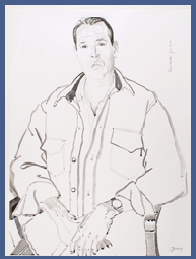 |

 ritic
Joseph Cady has labeled two kinds of AIDS writing as immersive and
counterimmersive. Paul Monette's is of the first category and demands
that the reader look at and experience the pain of the disease instead
of a distancing "leafsong gooseflight / frost why me." ritic
Joseph Cady has labeled two kinds of AIDS writing as immersive and
counterimmersive. Paul Monette's is of the first category and demands
that the reader look at and experience the pain of the disease instead
of a distancing "leafsong gooseflight / frost why me."
Monette realized that in going back to poetry, he would have to have
a different style. The words aggregate on the page and must be read
in a rush, a fury that was held by Monette himself. Monette addressed
this difference in style even in the poems themselves, as in "Gardenias":
pain is not a flower pain is a root
and its work is underground where the moldering
proceeds the bones of all our joy winded
Los Angeles psychotherapist and writer Betty Berzon recognized
the aptness of this style when she was shown the poems, probably before
publication: "[E]ach time I find [the elegies] richer and more powerfu—-and
not quite as painful as at that shock of first reading.. I think you
are right in the lack of punctuation. Ideas, emotions, images, are
pushing one another across the page-no time for commas here."
Writer Gregory Kolovakos, who also had AIDS, expressed in a letter
to Monette the divisions Monette dramatized. Kolovakos was on the
side of immersive writing and was also impatient with the gay community's
often too polite behavior. His sympathies were with Monette and ACT
UP founder Larry Kramer, whose art turned political instead of writing
in a less harsh style about AIDS, the counterimmersive style identified
by Cady.
Monette's early poet friend J.D. McClatchy wrote of this division
between himself and Monette and didn't respond to Monette's newer
poetry, saying that Monette's choosing to be political and to express
his rage diminished his art: "Art's afterlife eluded him."
Monette again benefited from the array of gay publishing available
ten years after publication of his first gay novel and at almost the
end of the second decade of gay liberation literature. Christopher
Street advertised its publication of selections from the elegies
on the cover of issue 119, using a snapshot of Monette and Horwitz
taken in Italy as illustration. Mark Thompson, then an editor at The
Advocate, reluctantly rejected the offered poems, since the Advocate's
policy was never to publish poetry. The American Poetry Review
and others accepted selections from the work. Editor Michael Denneny
published the entire cycle at St. Martin's Press, again using the
snapshot, this time in color, for the dust jacket.
Monette thus had a large audience for something as difficult as his
late poetry with its raging subject matter and the bald and austere
style that he created in order to project this. Kolovakos wrote Monette:
"I keep buying copies so that friends will have to confront what you're
saying." For a book of poems written for the gay community, Monette
received dozens of fan letters, probably almost unheard-of for most
poets to receive other than from a few fellow poets and friends and
students.
Fellow poets, such as Alex Gildzen, did write with praise: "Today
y[ou]r grief became mine because in reading y[ou]r poem cycle I was
permitted to share what was a great love." Gildzen later composed
"Summer's End," a brief lyric which complements Monette's summer imagery.
The influence of Monette's words in Love Alone was spread
when composers set them to music. Ned Rorem set "Here." At Monette's
suggestion, UCLA's Roger Bourland set the conclusion of the prose
introduction to the volume, the stirring passage ending: "All there
is is love."
These words and music in combination were made more moving by their
performance through a new cultural institution, gay men's choruses
active in several American cities. Rorem's setting was performed at
Tanglewood and in New York, where reviewers noted that Rorem's setting
"renders Paul Monette's poem . with eloquence and directness." Bourland's
work received praise when premiered by Los Angeles's chorus. For one
listener "it opened a sense of hope."
Rorem wrote Monette that he was "very very moved while working" to
set the poem, although "[a]s a Quaker and pacifist I'm a little disconcerted
by the image of lovers as warriors," the image given in the introduction
to the elegies. That idea of warriors fighting together-lines included
in Bourland's setting-would be central to Monette's next work, Borrowed
Time: An AIDS Memoir.

|
|

Letter from Mark Thompson to Paul Monette
Color
snapshot used on the Christopher Street cover
Cover of Christopher Street magazine with Paul Monette and Roger Horwitz
Gay
chorus performance of work based on Paul Monette's Love Alone
|

![]()
![]()
![]()
![]()

 ritic
Joseph Cady has labeled two kinds of AIDS writing as immersive and
counterimmersive. Paul Monette's is of the first category and demands
that the reader look at and experience the pain of the disease instead
of a distancing "leafsong gooseflight / frost why me."
ritic
Joseph Cady has labeled two kinds of AIDS writing as immersive and
counterimmersive. Paul Monette's is of the first category and demands
that the reader look at and experience the pain of the disease instead
of a distancing "leafsong gooseflight / frost why me."